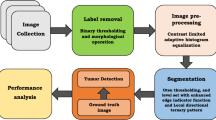Abstract
Computed tomography (CT) imaging is widely used for control and diagnosis of diseases nowadays. Segmentation of medical images is quite important, especially for diagnosis and treatment of cancer. In this study, similar and different tissues in CT images of liver are determined by using two different methods; watershed and histogram thresholding. The images have been preprocessed before segmentation. First, images are converted to grayscale. Next, they are smoothed with a bilateral filter. To apply the watershed technique, edges are extracted with a Gradient operator. The over segmentation of the watershed method is overcome by merging the closest segments in terms of their features. The merging is obtained via vector quantization of the features; fuzzy c-means clustering and k-means clustering algorithms by grouping mean and standard deviation of segments. The images are divided into five segments corresponding to liver, vertebra, tumor, lining and others. In the histogram thresholding method, multi thresholds are obtained with Otsu method from the smoothed image and segmentation has been performed. The results of two approaches have been compared. Pixel value, directional derivatives (DD), local binary patterns (LBP), difference of pixel with its neighborhood (DP) are employed as features to determine the segment class. Classifications of the regions were obtained from a single pixel and segment separately by dividing 44 liver images to two training (22 images) and test sets (22 images). The best accuracy for classification from a pixel was obtained 95.64 % with difference of pixel with its neighborhood feature whereas 98.88 % was obtained for categorization from the whole segment with directional derivatives feature by using histogram thresholding algorithm. This application may help physicians to distinguish and determine the similar or different tissues in the medical images.
Preview
Unable to display preview. Download preview PDF.
Similar content being viewed by others
References
1. Cancer Statistics (in Turkish) at http://www.kanser.gov.tr (Available at: 10.12.2016)
2. Shojaii R. (2005) Automatic lung segmentation in CT images using watershed transform. Image Processing CIP 2005. IEEE International Conference on (Volume: 2)
3. Ng H P, Ong S H, Foong K W C et al. (2006) Medical Image Segmentation Using K-Means Clustering and Improved Watershed Algorithm. Image Analysis and Interpretation, IEEE Southwest Symposium on, 61–65
4. Sharma Y, Kaur P. (2015) Detection and Extraction of Brain Tumor from MRI Images Using K-Means Clustering and Watershed Algorithms. International Journal of Computer Science Trends and Technology (IJCST), Volume 3, Issue 2.
5. Huang Y, Chen D. (2004) Watershed segmentation for breast tumor in 2-D, Sonography. May 2004, 30: 625–632
6. Das A, Sabut S K. (2016) Kernelized fuzzy C-means clustering with adaptive thresholding for segmenting liver tumors. Procedia Computer Science. Volume 92, 389–395.
7. Mustaqueem A, Javed A, Fatima T. (2012) An Efficient Brain Tumor Detection Algorithm Using Watershed & Thresholding Based Segmentation, International Journal of Image, Graphics and Signal Processing (IJIGSP), 4: 10.
8. Patil B G, Jain S N. (2014) Cancer Cells Detection Using Digital Image Processing Methods. International Journal of Latest Trends in Engineering and Technology, Vol. 3, Issue 4.
9. Deswal S et al. (2015) A Survey of Various Bilateral Filtering Techniques. International Journal of Signal Processing, Image Processing and Pattern Recognition. Vol. 8, No. 3. 105–120.
10. Paris S, Kornprobst P, Tumblin J et al. (2008) Bilateral Filtering: Theory and Applications. Foundations and Trends in Computer Graphics and Vision, Vol. 4,1–73.
11. Gonzalez R C, Woods R E. (2002) Digital Image Processing. Second Edition. Prentice-Hall, Inc., New Jersey. 793p.
12. Solomon C, Breckon T. (2010) Fundamentals of Digital Image Processing: A Practical Approach with Examples in Matlab. Wiley-Blackwell. Hoboken, New Jersey, US. 344p.
13. Arora S, Acharya J et al. (2008) Multilevel thresholding for image segmentation through a fast statistical recursive algorithm. Elsevier, Pattern Recognition Letters 29. 119–125.
14. Huang D, Shan C, Ardebilian M, et al. (2011) Local Binary Patterns and Its Application to Facial Image Analysis: A Survey.
Author information
Authors and Affiliations
Editor information
Editors and Affiliations
Rights and permissions
Copyright information
© 2018 Springer Nature Singapore Pte Ltd.
About this paper
Cite this paper
Avşar, T.S., Arıca, S. (2018). Automatic Segmentation of Computed Tomography Images of Liver Using Watershed and Thresholding Algorithms. In: Eskola, H., Väisänen, O., Viik, J., Hyttinen, J. (eds) EMBEC & NBC 2017. EMBEC NBC 2017 2017. IFMBE Proceedings, vol 65. Springer, Singapore. https://doi.org/10.1007/978-981-10-5122-7_104
Download citation
DOI: https://doi.org/10.1007/978-981-10-5122-7_104
Published:
Publisher Name: Springer, Singapore
Print ISBN: 978-981-10-5121-0
Online ISBN: 978-981-10-5122-7
eBook Packages: EngineeringEngineering (R0)




